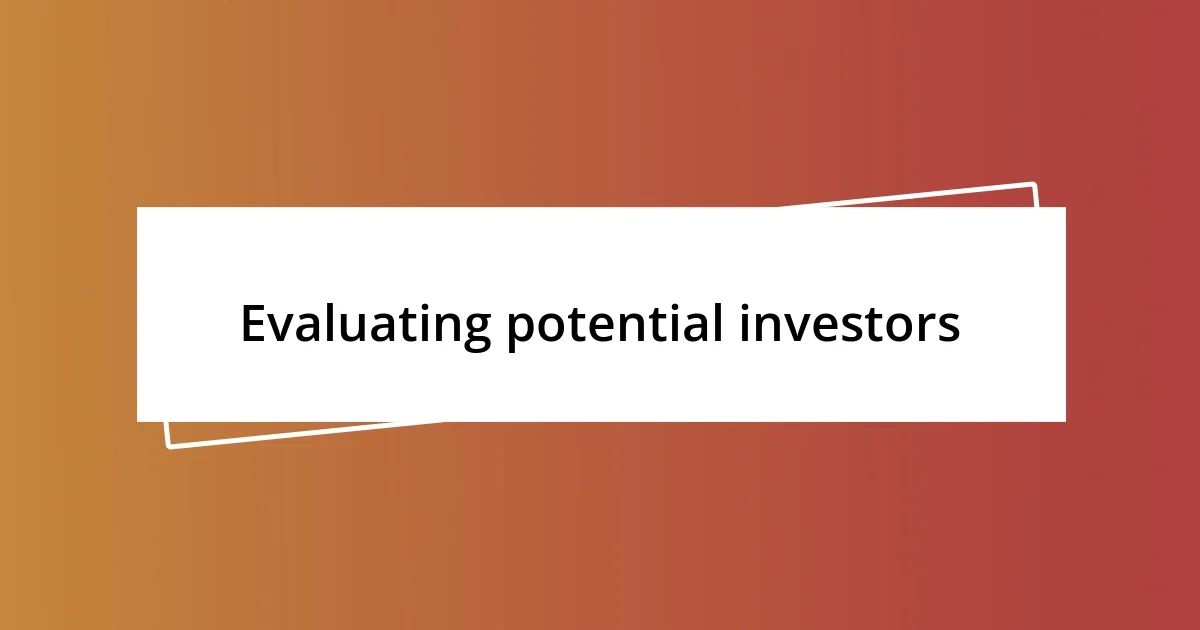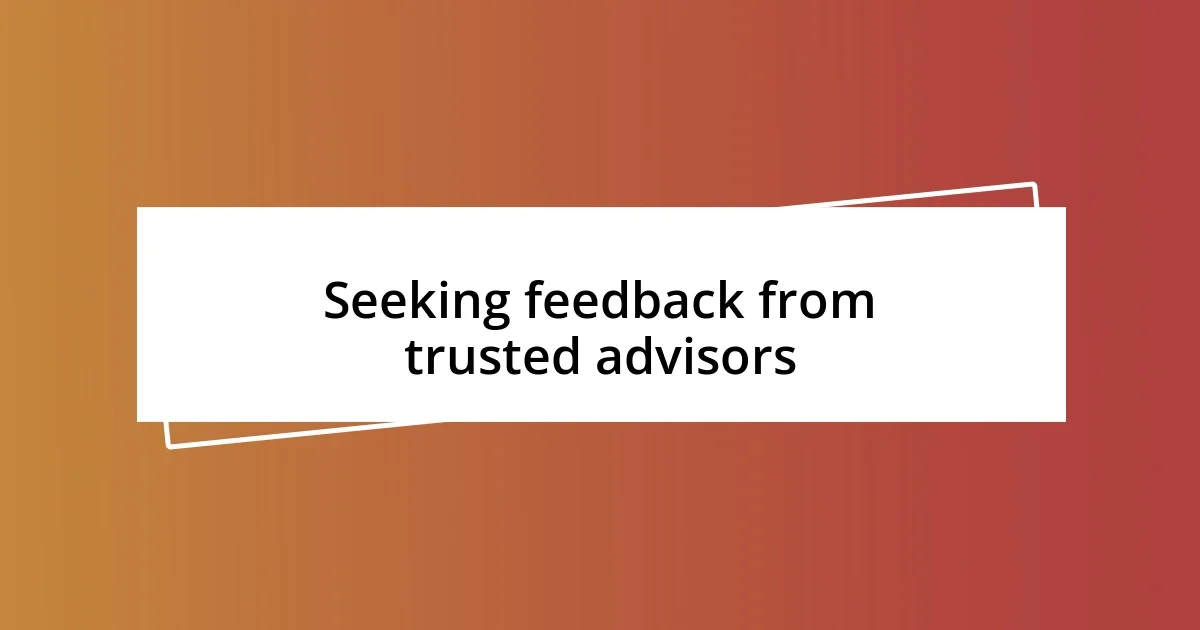Key takeaways:
- Understanding funding needs involves assessing essential versus nice-to-have funds, emphasizing realistic financial requirements for business growth.
- Evaluating potential investors requires aligning values, assessing desired involvement, and understanding their return expectations and history beyond mere numbers.
- Seeking feedback from trusted advisors is crucial in the decision-making process, as it helps illuminate blind spots and reinforces the importance of trust and communication in partnerships.

Understanding my funding needs
Understanding my funding needs involved a deep dive into what my business truly required at various stages. For instance, I vividly remember sitting at my kitchen table one late evening with spreadsheets strewn everywhere, trying to piece together how much capital I actually needed to launch my idea. It was a real eye-opener; I had to account for everything from product development to marketing, and I realized that wanting a large sum isn’t always the right approach.
One crucial aspect I learned was the importance of distinguishing between essential funds and nice-to-have funds. I often asked myself, “What would happen if I didn’t have this particular piece of equipment right now?” This question helped me prioritize my needs and determined the type of funding that best suited my vision. It was like peeling back layers of an onion, revealing fundamental needs versus desires.
As I defined my funding needs, I also had to embrace my emotional attachment to my project. I recall a time when I hesitated to ask for a larger sum because it felt daunting. But I realized that to grow, I couldn’t allow fear to dictate my decisions. Understanding my funding needs wasn’t just about numbers; it was about having the courage to reach for my dreams.

Evaluating potential investors
Evaluating potential investors goes beyond just reviewing numbers; it’s about understanding their vision, goals, and how they align with yours. I remember diving deep into the backgrounds of various investors, sifting through their portfolios like a detective searching for clues. What stood out to me was not just their past successes, but their values and how those resonated with my own. It became clear that emotional alignment is just as essential as financial backing.
I often found myself pondering a crucial question: “What does the investor expect in return?” I recall sitting at a café, coffee in hand, analyzing different investor profiles. Some sought quick returns, while others were interested in long-term growth. This distinction informed not just my decision-making but also shaped my pitches and relationship-building efforts. It’s all about finding the right balance; you want an investor who believes in your dream as much as you do.
Finally, I considered the level of involvement I wanted in my business. After all, some investors prefer a hands-on approach while others take a backseat. I learned this during a chat with a seasoned entrepreneur who once partnered with a firm that was overly involved, leading to friction rather than support. Ultimately, I wanted an investor who would not only provide capital but also guidance—without overshadowing my vision. Balancing these factors was essential in choosing the right partners.
| Criteria | Investor A | Investor B |
|---|---|---|
| Alignment with my vision | Strong | Moderate |
| Desired involvement level | Hands-on | Hands-off |
| Expected return timeline | Long-term | Short-term |

Analyzing investor track records
When I started analyzing investor track records, I quickly realized that numbers alone wouldn’t tell the whole story. I found myself running through spreadsheets and performance graphs, but the real insights came when I looked beyond the statistics. One investor’s recent fund surge made my heart race, but then I noticed a pattern of volatility that left me second-guessing stability. It was a wake-up call to understand that past performance, especially during turbulent times, was a more significant indicator of future behavior than flashy recent results.
Here’s how I approached analyzing track records:
- Diverse Portfolio: Did the investor have various holdings, indicating they manage risk effectively?
- Consistency: Were their returns steady, or did they experience drastic highs and lows?
- Sector Experience: Did they focus on industries that aligned with my business, demonstrating not just financial prowess but also relevant knowledge?
- Reputation and References: What did others in the industry say about their involvement and support?
- Crisis Management: How did they perform during market downturns or challenging economic periods?
Oftentimes, I’d find myself discussing these metrics with mentors over lunch. Their insights and different perspectives were invaluable. They encouraged me to consider how the investor’s history reflected their capacity for adaptability and resilience, qualities I wanted in a partner. This realization reshaped my approach, prompting me to dig deeper into the human side of these investors, seeking to understand their journey rather than just their numbers.

Assessing terms and conditions
When it comes to assessing terms and conditions, the fine print can often feel overwhelming. I remember sitting at my kitchen table, a sea of documents spread out in front of me, feeling like I was deciphering a secret language. I asked myself, “Are these terms going to empower my vision, or are they going to tie my hands?” It was crucial for me to dissect the agreements carefully, looking for clauses that might restrict my creative freedom or impose burdens that could stifle growth.
One moment that really stood out was when I encountered a non-compete clause that seemed innocuous at first glance. However, after discussing it with my mentor, I realized it could limit my ability to pursue other opportunities in the future. Does this sound familiar? I suppose many experience that moment when it hits you: what seems favorable on the surface can have long-term ramifications. I learned to negotiate not just for immediate gains but for the kind of flexibility that would allow my business to evolve unencumbered.
Another key aspect I focused on was understanding the financial implications of various terms. I distinctly remember the discussion where one investor’s interest came with hefty fees for early exits. This made me question: “Am I comfortable with terms that seem favorable but could cost me down the line?” I ultimately prioritized clarity and fairness in their proposals, ensuring that the conditions aligned with my long-term goals. In the end, it wasn’t just about securing funds; it was about crafting a partnership that would foster mutual growth for years to come.

Considering alignment of vision
When I started to assess the alignment of vision with potential investors, it became clear that shared values were non-negotiable for me. I remember one meeting vividly where the investor passionately discussed their approach to sustainability. It struck a chord with me because my own goals revolved around eco-friendly practices. I asked myself, “Could I genuinely collaborate with someone who doesn’t understand or share my priorities?” It was a moment of clarity that solidified my belief in the importance of finding partners who not only supported my business ambitions but also resonated with my core beliefs.
Diving deeper into conversations about vision, I sought to understand the investor’s long-term aspirations. One investor excitedly mentioned plans for expanding into international markets, which was a thrilling idea. However, I paused and thought, “Does their vision conflict with my commitment to local community engagement?” This tension highlighted the necessity of alignment; having divergent goals could lead to friction down the road. I visualized our potential relationship like a duet—the harmony of our visions needed to be in sync if we were going to create something beautiful together.
Ultimately, I found that alignment goes beyond just shared interests; it’s also about mutual respect for the journey. During one candid conversation, an investor admitted their past mistakes, which I found refreshing. I couldn’t help but think, “Have I been open about my own lessons learned?” Their vulnerability made me feel that this investor genuinely valued the ups and downs of entrepreneurship. It reinforced my understanding that a partner should not only complement my vision but should also be willing to navigate challenges together, ensuring we both grow in the process.

Seeking feedback from trusted advisors
Seeking feedback from trusted advisors was a pivotal part of my decision-making process. I vividly recall a lunch meeting with my business coach, where I laid out my top investor options. As I spoke, I noticed their thoughtful nods and probing questions, prompting me to consider aspects I hadn’t even thought of yet. Have you ever had that “a-ha” moment when someone else’s perspective illuminated blind spots in your thinking? It’s enlightening how a trusted voice can clarify your own thoughts.
Often, the advice I received was wrapped in personal experiences. One seasoned entrepreneur shared a story about a partnership that soured because they ignored red flags during their due diligence. Listening to their account, I could feel the weight of their regrets. I remembered feeling emotional as they emphasized the importance of trust and communication, driving home that gut feelings are not to be ignored. How often do we overlook instincts, thinking they’re just baseless fears?
I also learned that seeking feedback is not merely about gathering opinions; it’s about creating a safe space for honest dialogue. I distinctly recall reaching out to a former colleague whose input I value immensely. During our call, they cut right to the chase, dissecting my draft of potential terms like a hawk. Their candidness reassured me that real advisors are not afraid to challenge your thoughts. It led me to ponder, “Am I prepared to embrace constructive criticism?” This experience reinforced my belief that the right feedback can empower you to make informed choices that resonate with your vision.

Making the final decision
As I approached the final decision, I felt a unique blend of excitement and anxiety. I vividly remember staring at my notes, weighing the pros and cons of each investor. It was like deciding which path to take on a winding road—each option seemed promising, but I knew a misstep could lead me far from my destination. I often wondered, “Am I truly considering what aligns best with my goals?”
In those moments of reflection, I relied heavily on my instincts. One afternoon, sitting alone in my office, I thought back to how each investor made me feel during our conversations. Did any of them ignite a spark of inspiration? One investor’s passion resonated deeply with me, but their approach felt overly aggressive. I wrestled internally, asking myself, “Would I feel comfortable in that dynamic?” Trusting my gut became an essential part of my evaluation process.
Ultimately, I had to remember that choosing an investor was also about choosing a partner. During a late-night brainstorming session, where thoughts freely flowed, I realized the importance of collaboration. Could I see myself sharing those late nights and breakthroughs with this investor? Their willingness to listen and engage made all the difference. I sensed that our potential journey would be a dance of ideas, and it was crucial that we were rhythmically aligned.














